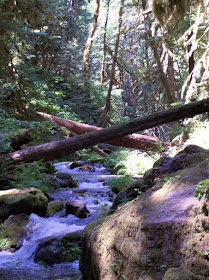
Matheson Lake Regional Park in Metchosin is a forested area that features a cover of newer trees interspersed with old growth. Although the hillsides are mostly covered in younger trees, and there is evidence of old logging activity, this remains a beautiful spot. There are enough ancient holdovers from pre-logging days to keep you cycling or hiking along to find the next one.
Some of the trees in Matheson Lake Park are hundreds of years old. The newer forest has filled in and some second growth trees are getting large, too. If one were into bush whacking many more giant trees can be found hiding up the steep hillsides and screened by surrounding forest. I have read of such trees in obscure places on the Internet, and have tried finding some of them, but to no avail... so far.


The Galloping Goose Trail passes through the park, and is a good way to see the several wide Douglas-firs on both sides. Some have circumferences over 20 feet. There is also a smaller scenic 3.4 km trail that circles Matheson Lake. This trail undulates through thick forest and over steep hillsides and rocky outcrops.
The tree on the right is along the lake shore trail and caught my attention. It looks like someone in the past started to cut it down and changed their mind. It still bears the scar, although it is filling with sap and debris. This Douglas-fir tree is still living, and can be found at the west end of the lake just off the trail.

The Western red-cedar stump above shows more evidence of logging activity in the past. The notches are for springboards that loggers used to elevate themselves above the thickest part of the tree to make cutting easier. Now that the area is protected as a park we can allow the forest to develop unmolested. In a couple of hundred of years it will take on the characteristics of old growth.


There are large cedars along the lake shore trail, as well as Hemlock. At the right time of year you will also find many showy wildflowers gracing the hillsides.

Matheson Lake is stocked with trout and makes for a fun day of paddling and fishing. The lake has a nice pocket beach at the east end, and swimming is popular here. Salamander like to swim in these waters, too. On one visit I saw an endangered Western painted turtle. Watch for these amazing creatures as they group together to share a nap on a floating log.

Getting There
View Larger Map
Matheson Lake Regional Park is on the border between Sooke and Metchosin. It can be accessed from Rocky Point Rd by turning onto Matheson Lake Park Road and taking it to the end where there is a parking lot with connections to the Galloping Goose Trail as well as the Lakeshore Trail. Matheson Park is connected to Roche Cove Park, and can be accessed from the Roche Cove Parking off Gillespie Road. The Galloping Goose trail passes through Roche Cove Park, and on to Matheson. All side trails are clearly marked. As usual out here, watch for bears and cougars. Make noise as you hike.













